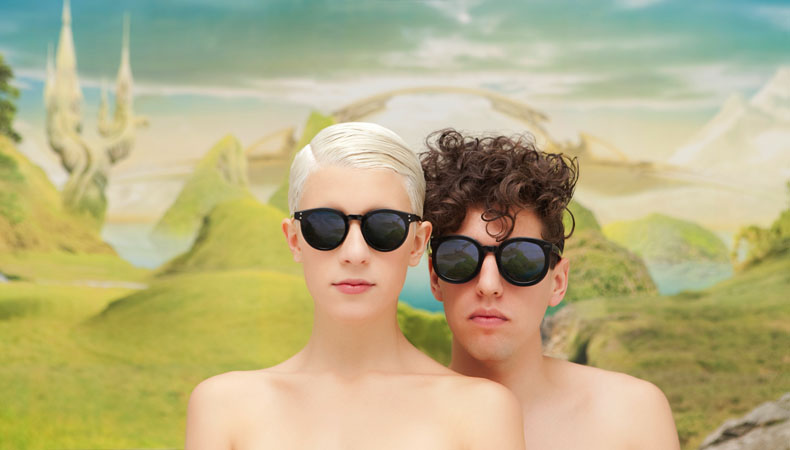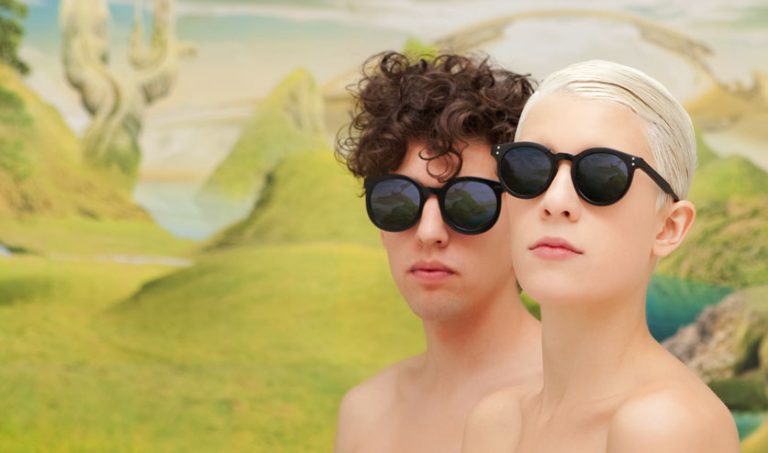YACHT is an indie-pop band that is deeply into mysticism, philosophy, art and they use music as a vehicle to present their ideological message to the world. YACHT was started 10 years ago by Jona Bechtolt. The band name is an acronym that stands for Young Americans Challenging High Technology which was an after school program in Portland, Oregon that Bechtolt loosely attended in his youth. In 2008, singer Claire Evans joined Bechtolt full-time and her addition was the perfect element the band needed to propel itself to new heights. Albums such as 2009’s See Mystery Lights and 2011’s Shangri-La are perfect examples of her contribution to their thought provoking music. Claire took time out from her European tour to talk with us about YACHT.
YACHT has evolved since its 2002 debut, can you tell me where this incarnation of the band finds itself today?
YACHT always strives towards increased physical presence. While it began as a solo project and expanded to become a duo in 2008, it’s now a core group of four touring members and a tight-knit community of like-minded friends and participants. We strive to become something like an autonomous nation someday, the ultimate in physical experience.
What is your relationship with Marfa, TX and how has it contributed to your creativity?
Marfa’s the spiritual homestead. A face-to-face encounter with Marfa’s famous “mystery lights” is what catalyzed us to become a collaborative duo in 2008; in an economy of aesthetic purpose, we realized that our shared conversation would broadcast more loudly if we shared it with the world. Now we write and record our most significant projects partially or entirely in Marfa. We have a theory that Marfa is the real world and everything else is just an illusion–occasionally we need a dose of that reality.
Aside from the mystery lights, is there anything else in Marfa you would recommend someone to go check out?
Marfa is perhaps more known for being an art world destination than one for paranormal sightseeing. The American minimalist sculptor Donald Judd moved his entire operation out to West Texas in the middle of his career and now the town is literally anchored with priceless pieces of American art. They actually dot the landscape, monolithic cubes of concrete and milled aluminum. People travel from all over the world to see it, and it keeps the culture of the town perpetually interesting, always changing. In general, it’s a very inspiring place to be.
Can you tell me a little about your album See Mystery Lights?
See Mystery Lights is the product of our first few months living in Marfa. We threw ourselves into the experience, really living in the desert, and came out of a fog after two months with this psychedelic pop object called See Mystery Lights. It actually began as a collection of mantras, short manifestos. We built them into songs because they made more sense that way, and could be carried further afield. In a sense we began to understand the similarity between pop music and mantra: both stick in your mind.
You also have a book out titled The Secret Teachings of the Mystery Lights: A Handbook on Overcoming Humanity and Becoming Your Own God. Can you tell me a little about that book?
It’s the text version of the album of the same name. For us, YACHT is a name we give to all our shared efforts, which include texts like that one, video, music, design, and a personal philosophy that we occasionally share. For people uninterested in music (or rather, our music) we try to impart our ideas under different forms, different guises. We don’t expect everyone to like all of it, but are interested in being comprehensive. It’s what we want from the artists that we love, that feeling of being able to tip over into the rabbit hole…

Which philosopher/s do you draw influence from? Identify with? And who would you recommend an audience member to read up on?
Our philosophical influences vary from project to project. For See Mystery Lights, we were fascinated with human ritual, esotericism, and spirituality, and so we were reading a lot of metaphysical texts and surveys, as well as poking into facets of the occult, exploring fraternal organizations, cults, and mystery schools. A huge influence on that album was Manly P. Hall’s The Secret Teachings of All Ages, which is a comprehensive encyclopedia of the so-called “left-hand” path written by a 33rd degree Mason and scholar. We also read Anton LaVey, Aleister Crowley, and some more silly things. In making Shangri-La, we were hyped on the notion of Utopia, and so we read a great deal of that canon: Thomas More, H.G. Wells, Francis Bacon, Transcendentalism, Charles Fourier, and the breathless tracts of countless hippie, anarchist, and separatist groups. Ultimately our personal philsophy is self-formed, but undoubtedly cobbled together from some combination of utopian science fiction ideas, the great psychedelic project, Robert Anton Wilson’s idea of “reality tunnels,” and the straight-up DIY ethics of our own punk rock initiations.
Can you tell me a little about the triangle symbol you use? What does it represent and how is it significant/relevant to your music?
We chose the triangle because we wanted a form from which people could draw multiple meanings. We like complexity of ideas in economical forms: as much as possible from as little as possible, like Buckminster Fuller said. Essentially, the triangle, as a symbol, is ancient and fundamental. Carl Jung argued that the arrangement of deities into triplets is an archetype in the history of religion, and it moves beyond that: the Christian trinity, the Masonic “Delta,” the mathematical symbol, the architectural form, the gay rights logo, the Hindu Trimurti. It means so much that it means nothing, and so people can never tire of it.
Can you tell me a little about your album Shangri-La and the muse that fueled it?
Shangri-La is an album about Utopia. At the time, we were interested in Utopias because we saw them as a way to physicalize ideas. Literally, a Utopia is a place made of ideas, something people do when they are so devoted to their ideology that they want to vote for it with their lives. As people who’d been thinking about ways to “walk the walk” of personal philosophy, the concept appealed to us. We used the recording of the album as a way to explore this–for us, research and work go hand in hand. In the end, we discovered that Utopia is untenable.
How was the creative and recording process of Shangri-La the same/different from See Mystery Lights?
For one, it was the first and only album to date that we have recorded in a studio–all our previous efforts were the product of a single microphone and borrowed equipment. That said, we used the studio “wrong.” We brought nothing into it, and wrote all the songs while we were there, so they are literally direct products of our experiences and thoughts during the months we were recording. Shangri-La is a document of three months spent in what we call the “Western American Utopian Triangle” (Marfa, Texas, Portland, Oregon, and Los Angeles, California), in studios and rented homes, living, thinking, and writing.
What do you look forward to most when you’re out on tour? Is there any city/venue that holds a special bond with you? Why?
For us, being on the road is a constant. We are literally always on tour. In that sense, there’s nothing (and everything) to look forward to: a constant whirl of new places and experiences. Every day is new.
Have you been to El Paso, TX before? What are your thoughts on El Paso?
We fly into El Paso every time we visit Marfa. I can honestly say that we’re thrilled to be able to connect with El Paso itself after all these years spent using it as a starting point for our desert adventures.
You’ve toured with LCD Soundsystem and the Yeah Yeah Yeahs, to name a few, is there any band or artist out there (alive or dead) you’d be curios to hit the road with? Why?
We’re looking forward to doing a short tour in the US with Hot Chip, who are untouchable geniuses.
TXT: Alex Duran | PHOTO: Alin Dragulin


